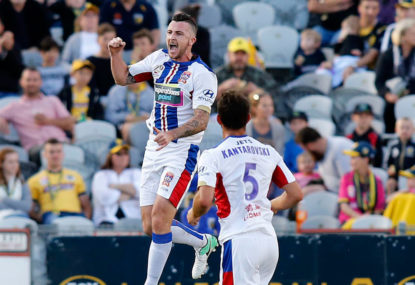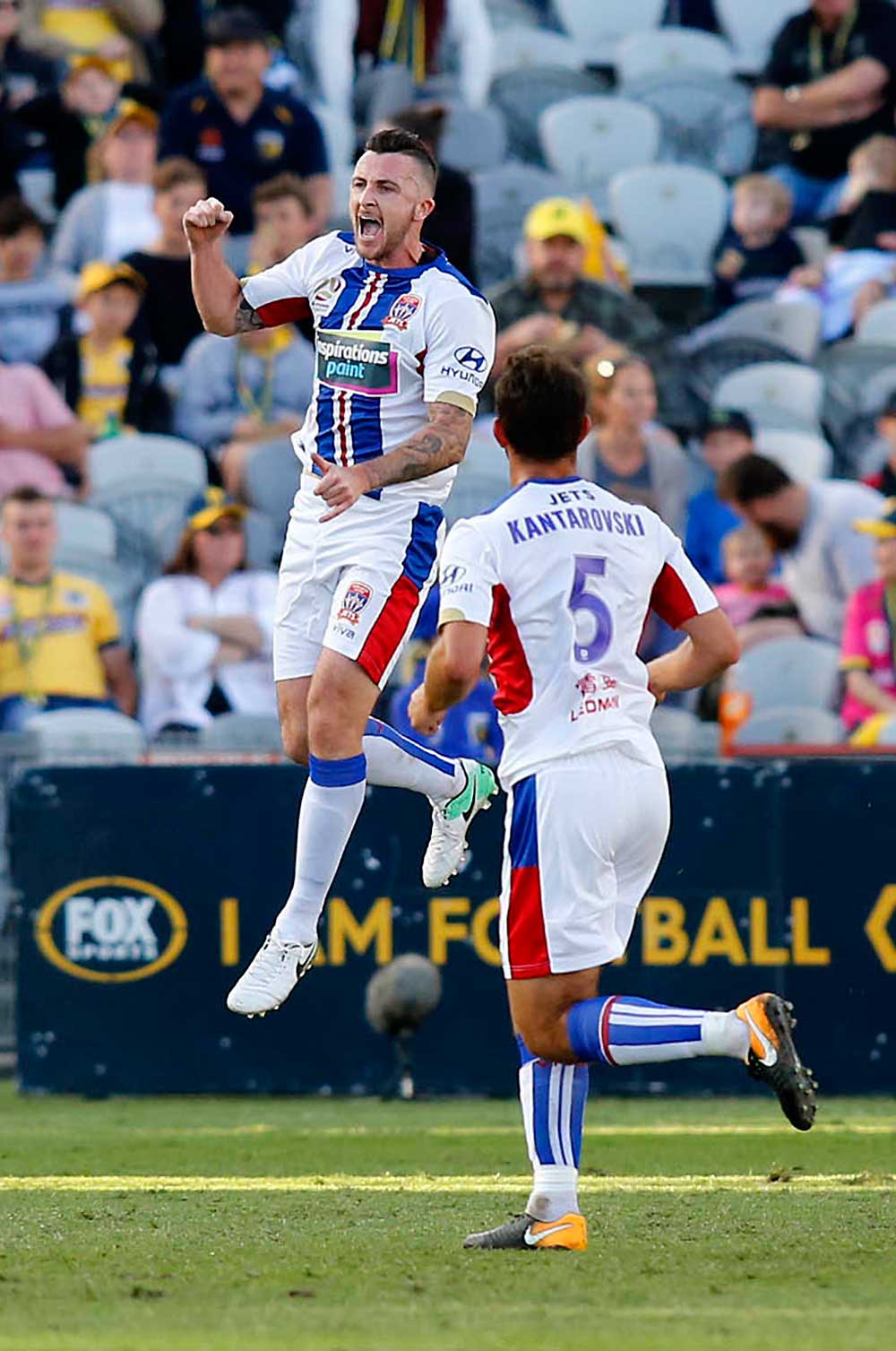Young excellence, promotion battles, and a happy farewell: The Australian team of the week from players around the globe
Even though St.Pauli ultimately lost a high-scoring affair, Jackson Irvine was a standout, as well as scoring a late goal.

The video assistant referee-affected 2-2 draw with the Western Sydney Wanderers on Friday was Roy O’Donovan’s second game back from an extended injury convalescence.
The Jets – not coincidentally – have suffered all four of their defeats in matches where they’ve been without their Irish striker. His seven goals in nine games this season is as tangible an impact as could be expected, but his performance against the Wanderers – the effects of which weren’t chiselled into the scoreboard – quietly communicated a subtler kind of value, just as treasured as the lustrous currency of goals and assists.
An off-the-shoulder striker always applies pressure to a back line. Merely the threat of scoring a goal like this is enough to compromise the integrity of a defensive system, turning a calm marker into a skittish, fretting victim. Furthermore, the effects of this aren’t exclusively to the benefit of the said striker; it causes waves of knock-on effects to ripple through the match, benefiting teammates and hindering tangential opponents.
[latest_videos_strip category=”football” name=”Football”]
The reputation for scoring a goal like O’Donovan did for the Mariners against the Wanderers last season is a good start, but the threat must also be reasserted on the day too, and O’Donovan wasted little time on Friday, even though Newcastle began the game sluggishly. Just 20 minutes in, a rudimentary long ball sent a scampering O’Donovan through, forcing Vedran Janjetovic to intervene with a diving header.
A lovely pass, to be sure, but the well-timed run and sudden burst of speed were just as important. The chance sent a ripple of alarm through the Wanderers defence, and you can bet Janjetovic would have made clear exactly how much he appreciated being forced to assume a horizontal airborne position in the open field.
A few minutes later another handsome hoof connected with a dashing O’Donovan, this time running from the inside out, snagging the attention of the full width of Western Sydney’s defence. Two clear warnings.
O’Donovan must be a nightmare to play against, a slippery presence up front, who will often take weak-side positions – you can see him lingering at the top-right of the frame – to drag defenders away from the ball. There is nothing more worrying for a defender than this kind of wavering opponent, seemingly uninvolved but at the same time worthy of near constant and almost paranoid attention.
So, now established in this match as this specific kind of attacking hazard, here’s an illustrated example of how O’Donovan’s ‘gravity’ affects the Jets’ attacking functions even when he isn’t tangibly utilised.
Of course this promising situation was aided by the fact it occurred against a team playing Roly Bonevacia, Marcelo Carrusca and Steve Lustica as a midfield trio, none of whom could be described as one of the league’s premier defensive midfielders and who acted as such here. But the space that Patito Rodriguez enjoyed was as much the result of O’Donovan’s gravity as it was anything Western Sydney did or didn’t do. This is just one small example of the phenomenon in action; there would be a rather more eye-catching example later on.

(AAP Image/Darren Pateman)
O’Donovan’s return to the starting striker’s role has a supplementary benefit too: returning Andrew Nabbout to a more flexible alternative position in the starting XI.
Nabbout is more than capable in the centre forward’s role – he has six goals and three assists in 12 starts as striker – but his assets as a player are generally more suited to the wider ranges near the wings, or at least in areas where he has more time and space to work with on the ball. He is best where he is not teetering on the edge of that sheer drop into offside territory. Nabbout has been found offside on more occasions than any player in the league.
Nabbout’s hustle is phenomenal. In the deeper midfield areas, with the ball circulating, he revels in the barging and the charging, dribbling through bodies, banging speculative passes, harrying opponents off the ball and just generally making a robust, physical nuisance of himself.
He can also utilise these qualities to assist defensively from wider positions, something it would be hard to provide sitting on the shoulder of the last man.
He’s such a powerful, eager attacker, and it seems a shame not to use him in the role that takes full advantage of this. Don’t underestimate the value of getting Nabbout involved in the thick of the action either; he is a player for whom confidence seems paramount and for whom things like touch and technique need to be thoroughly warmed up during matches.

(AAP Image/Darren Pateman)
For instance, how about the technique required to strike the ball with the outside of your foot, bending it just inside the far post, having burst through a maw of tacklers on the full sprint?
Although Nabbout’s wondrous equaliser seemed a moment of pure individual virtuosity, O’Donovan’s movement was, if not quite at the centre of it, then at least playing a crucial supporting role from the fringes.
You can see from the kick-off O’Donovan haring forward, dragging the defence back with him. The Western Sydney centre backs may have been expecting a long ball to the Irishman and were back-tracking accordingly to the point they both retreat into their own box and refuse to go out and meet Nabbout.
Nabbout and Dimi Petratos – two thirds of an attacking midfield line that had been fluidly interchanging positions all evening – both take up position on the right. O’Donovan’s run first makes room for Petratos to streak into and then ekes out further pasture for Petratos to backheel into.
Nabbout’s run, all bustle and inertia, leaves a slide tackle flailing in vain, and his shot is, well, let’s just say it’s a little better than the last time he applied the outside of his boot to the ball. Again, as in the illustrated chance detailed above, O’Donovan’s off-the-ball movement carves out space for his teammates to fill and flourish in.
The Jets have scored freely this season using sudden, direct passing as a key pillar of their attack. They have fewer passes per goal than any other team in the league. The viability of this approach hinges on O’Donovan’s skills, but those skills, as specific as they seem at first glance, offer so much more than just the bolstered hope that a long ball might be successfully chased down.
Newcastle are a better team with him in the side, even when he isn’t scoring – and as difficult as it might be to tear your eyes away from Nabbout’s wonder-goal, doing so allows us to see the subtler but no less important value O’Donovan holds for the Jets.